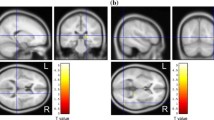Abstract.
Wilson's disease (WD) is a copper deposition disorder which can result in a number of extrapyramidal motoric symptoms such as parkinsonism. Therefore, this study was carried out to investigate, for the first time, nigrostriatal dopaminergic function in WD in relation to different courses and severity of the disease. Using high-resolution single-photon emission tomography (SPET) after administration of 2ß-carbomethoxy-3ß-(4[123I]iodophenyl)tropane ([123I]ß-CIT), striatal dopamine transporters (DAT) were imaged in 43 WD patients and a control group of ten subjects. From the SPET images, specific [123I]ß-CIT binding ratios were obtained for the caudate heads, putamina and entire corpus striatum. In addition, to evaluate a putative dissociation between the caudate and putaminal [123I]ß-CIT binding ratios, the ratio between these binding ratios was calculated (CA/PU ratio). The SPET data were compared with clinical data on the course of the disease (CD), the severity of neurological symptoms and the degree of hepatic alteration. Whereas the specific regional [123I]ß-CIT binding ratios in patients with asymptomatic/hepatic CD did not differ from those in the control group (e.g. striatal ratios: 13.4±3.0 vs 11.7±2.8), in patients with neurological CD the ratios were significantly reduced for all striatal substructures (P=0.003 after one-factor ANOVA). For the different subgroups a tendency was detected towards a stepwise decrease in the specific [123I]ß-CIT binding ratios from pseudo-sclerosis CD (9.4±2.3), through pseudo-parkinsonian CD (9.1±2.1) to arrhythmic-hyperkinetic CD (8.5±1.6). However, these group differences reached significance only for the comparison with asymptomatic/hepatic CD (P=0.02). The CA/PU ratio was significantly higher in WD than in the control group (1.30±0.19 vs 1.11±0.08; P=0.003). Severity of neurological symptoms was significantly correlated with all specific regional [123I]ß-CIT binding ratios (r=–0.49 to –0.57). For degree of liver alteration, significant correlations were obtained with the putaminal binding ratio (r=–0.37) and the CA/PU ratio (r=0.44). From these results is concluded that in WD the nigrostriatal dopaminergic function is compromised to varying extents. The degree of this presynaptic alteration of dopaminergic neurotransmission depends on the clinical course and severity of this copper deposition brain disorder and also varies in the different striatal substructures.
Similar content being viewed by others
Author information
Authors and Affiliations
Additional information
Received 1 March and in revised form 14 July 2001
Electronic Publication
Rights and permissions
About this article
Cite this article
Barthel, H., Sorger, D., Kühn, HJ. et al. Differential alteration of the nigrostriatal dopaminergic system in Wilson's disease investigated with [123I]ß-CIT and high-resolution SPET. Eur J Nucl Med 28, 1656–1663 (2001). https://doi.org/10.1007/s002590100623
Published:
Issue Date:
DOI: https://doi.org/10.1007/s002590100623




